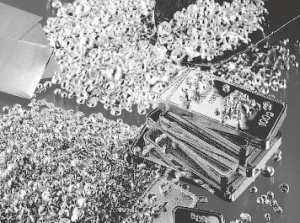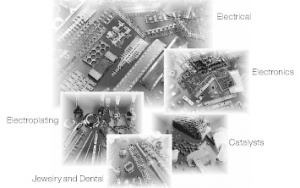Difference between revisions of "Precious Metal Refining"
Doduco Admin (talk | contribs) (→Precious Metal Recycling and Environmental Protection) |
Doduco Admin (talk | contribs) (→Refining Methods) |
||
| Line 15: | Line 15: | ||
Main Articel: [[Refining Methods| Refining Methods]] | Main Articel: [[Refining Methods| Refining Methods]] | ||
<figure id="fig:Examples_of_precious_metal_scrap"> | <figure id="fig:Examples_of_precious_metal_scrap"> | ||
| − | [[File:Examples of precious metal scrap.jpg|right|thumb|Examples of precious metal scrap]] | + | [[File:Examples of precious metal scrap.jpg|right|thumb|Figure 2: Examples of precious metal scrap]] |
</figure> | </figure> | ||
Revision as of 07:36, 13 December 2022
Contents
Precious Metal Recycling and Environmental Protection
Precious metal containing products which, after a certain time become obsolete or are generated as non-usable manufacturing scrap, are used widely in industry and the private household sector. Therefore it is particularly sustainable to return these expensive residues to the use-cycle of precious metals by reclaiming the contained pure metals such as gold, silver, platinum, palladium and rhodium (Figure 1).
Precious metal recycling is nowadays closely related to the protection of the environment. It is integrated into a complex network of processes that benefit the clean supply of water and protection of the air quality. The wastewater streams generated during refining processes are treated by special processes which remove hazardous components. High efficiency wet scrubbing and filtration of exhaust air is employed in all stages of the metal recycling processes.
Refining Methods
The precious metal containing products and materials submitted into the refining process are generally called precious metal scrap (Figure 2). They are usually classified into three categories which differ by the refining processes employed and by the cost-to-value ratio.
Main Articel: Refining Methods
Recommendations for Scrap Handling
Processing scrap, generated for example during contact manufacturing, usually consists of meltable material. Since refining costs are calculated based on gross scrap weight, the gain achieved through refining is highly dependent on the precious metal content and the current market value of the respective precious metal.
Minimizing stamping scrap should therefore be considered during the design of contact parts right from the beginning. Unavoidable precious metal containing scrap should be strictly separated from stamping scrap of base metals. It is also recommended to separate scrap by the types of precious metal contained as well as by base materials.
During shipping of refining scrap, all regulatory laws must be followed, including declarations for the content of goods, transportation and the intended disposal of residues of the base materials.
Refining Costs
- Melting costs
Melting costs are only charged for re-meltable scrap and are based on the gross weight of scrap delivered, as well as on the type of precious metal to be recovered. The processing required for palladium containing scrap is, for example, significantly more complex that the one for silver containing metal scrap.
- Preparation costs
Preparation costs are only assessed for the refining of low grade (sweeps) scrap and are grouped into quantity breaks. They cover all processing steps such as burning, shredding, milling and blending, up to the point of sampling.
- Analysis fees
Fees for the cost of content analysis vary by the type of precious metal and the form of the sample. Ash samples require significantly more work than pure metallic materials due to their high content of mineral substances.
- Refining costs
The actual cost of refining includes all separation steps and processes required to recover the precious metals. They are grouped into two sub-categories:
- Basic refining fees
These include all processing steps for the actual refining of the different metal components included in the scrap. The are charged according to the starting gross weight or the scrap weight after melting.
- Metal charge
This amount contains the costs for transforming the refined metals into the required grade of purity, and also the cost to convert the end metal product into a commercially re-usable form such as for example ingots or granulate.
Precious Metal Crediting Options
The supplier of precious metal scrap can choose between different ways of obtaining credit for the value of the refined precious metals:
- Delivery of precious metal in commercial form and quality.
- Sale of the precious metal at the daily market price and transfer of the net gain.
This gain can be applied as a credit towards delivery and invoicing of new and other products, it can be transferred into a so-called “metal account” for future use or applied as a financial credit to the scrap supplier's account.


